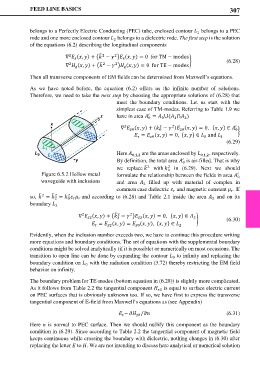Page 327 - Maxwell House
P. 327
FEED LINE BASICS 307
belongs to a Perfectly Electric Conducting (PEC) tube, enclosed contour belongs to a PEC
1
rode and one more enclosed contour belongs to a dielectric rode. The first step is the solution
2
of the equations (6.2) describing the longitudinal components
� 2
2
2
∇ (, ) + � − � (, ) = 0 for TM − modes � (6.28)
� 2
2
2
∇ (, ) + � − � (, ) = 0 for TE − modes
Then all transverse components of EM fields can be determined from Maxwell’s equations.
As we have noted before, the equation (6.2) offers us the infinite number of solutions.
Therefore, we need to take the next step by choosing the appropriate solutions of (6.28) that
meet the boundary conditions. Let us start with the
simplest case of TM-modes. Referring to Table 1.9 we
z have in area = ⋃( ⋂ )
′
1
2
0
0
x
2
2
2
∇ (, ) + ( − ) (, ) = 0, {, } ∈ ′ 0 �
0
0
0
= (, ) = 0, {, } ∈ and
0
0
1
(6.29)
Here 0,1,2 are the areas enclosed by 0,1,2 , respectively.
y By definition, the total area is air-filled. That is why
′
0
we replace with in (6.29). Next we should
2
� 2
0
Figure 6.5.2 Hollow metal formulate the relationship between the fields in area
′
0
waveguide with inclusions and area filled up with material of complex in
2
common case dielectric and magnetic constant . If
so, = = and according to (6.28) and Table 2.1 inside the area and on its
� 2
� 2
2
0
2
2
boundary
2
2
� 2
2
∇ (, ) + � − � (, ) = 0, {, } ∈ 2 � (6.30)
2
2
2
= (, ) = (, ), {, } ∈
2 0 2
Evidently, when the inclusion number exceeds two, we have to continue this procedure writing
more equations and boundary conditions. The set of equations with the supplemental boundary
conditions might be solved analytically (if it is possible) or numerically on most occasions. The
transition to open line can be done by expanding the contour to infinity and replacing the
0
boundary condition on with the radiation condition (3.72) thereby restricting the EM field
0
behavior on infinity.
The boundary problem for TE-modes (bottom equation in (6.28)) is slightly more complicated.
As it follows from Table 2.2 the tangential component is equal to surface electric current
0
on PEC surfaces that is obviously unknown too. If so, we have first to express the transverse
tangential component of E-field from Maxwell’s equations as (see Appendix)
~ ⁄ (6.31)
0
Here n is normal to PEC surface. Then we should nullify this component as the boundary
condition in (6.29). Since according to Table 2.2 the tangential component of magnetic field
keeps continuous while crossing the boundary with dielectric, nothing changes in (6.30) after
replacing the letter to . We are not intending to discuss here analytical or numerical solution

